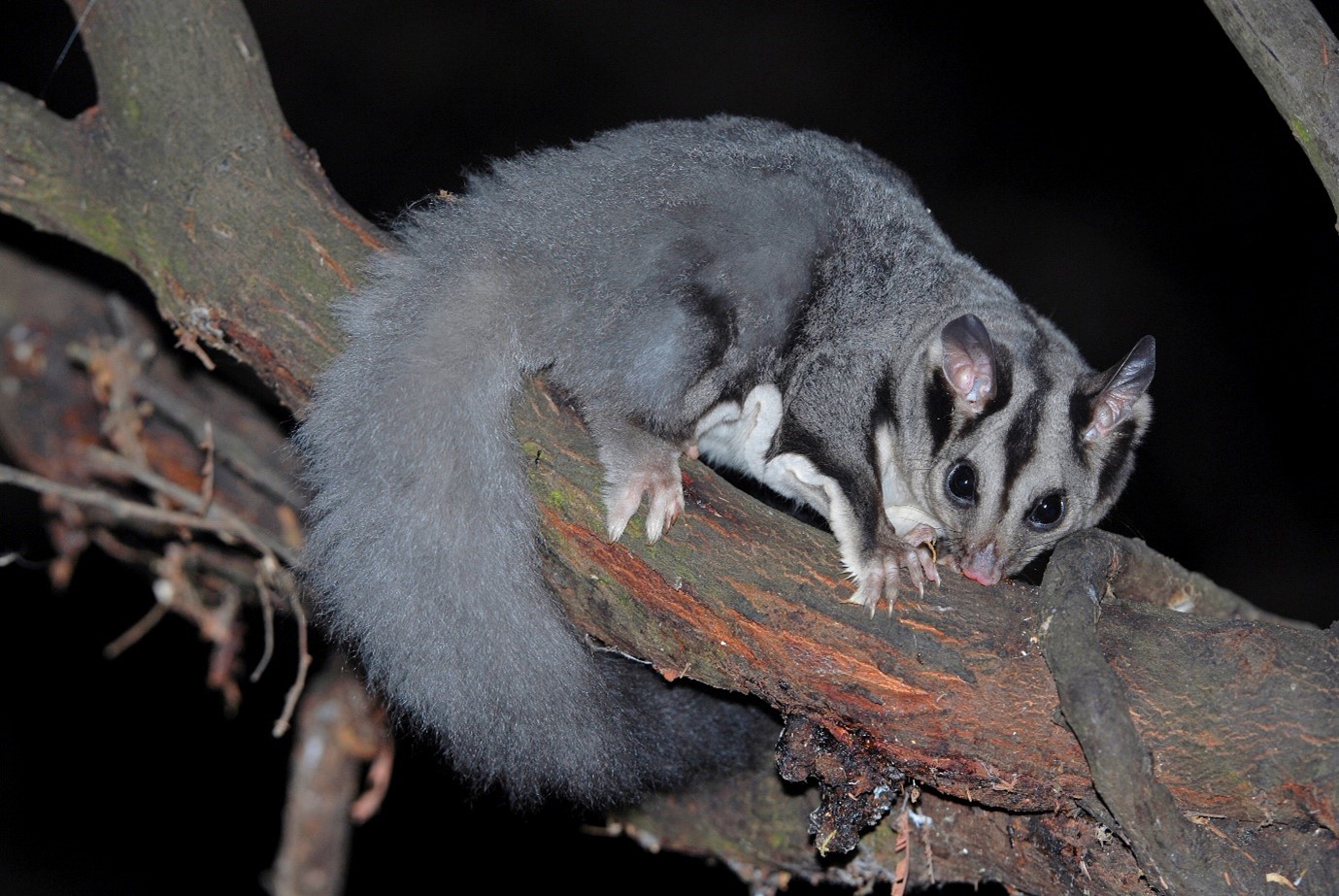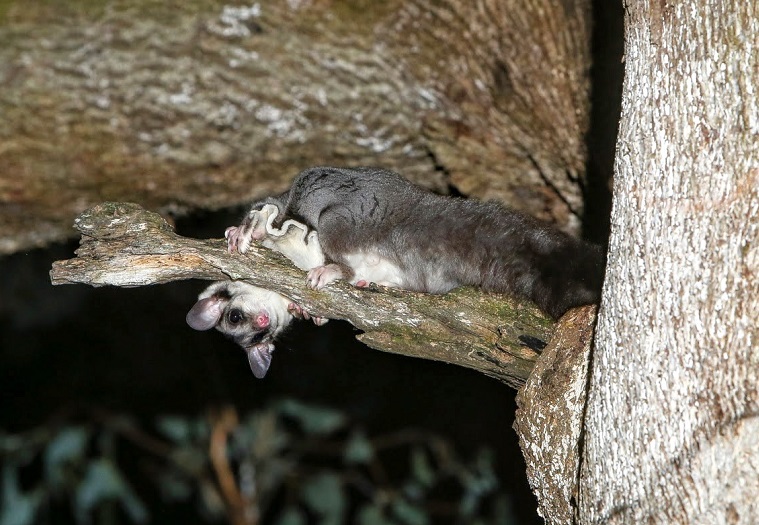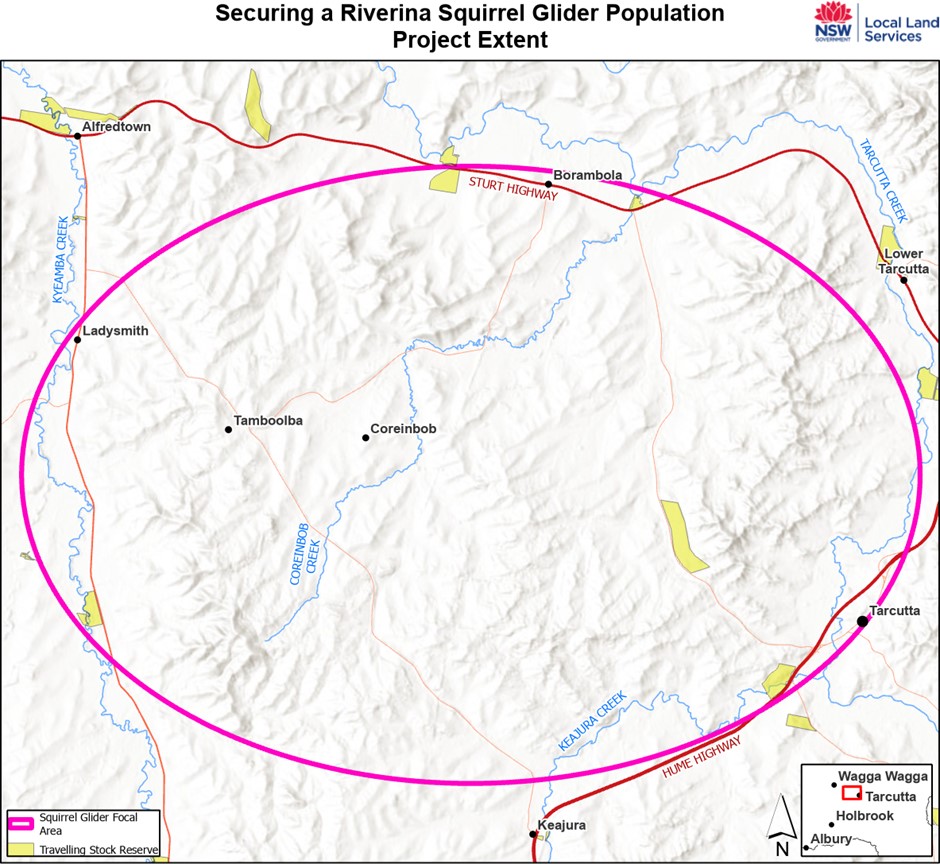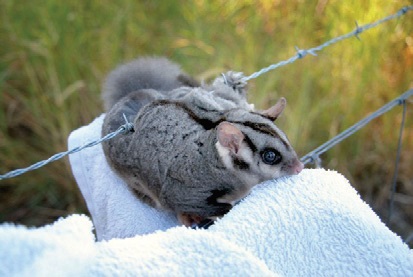Squirrel Glider
Petaurus norfolcensis
The Squirrel Glider is a mid-sized gliding possum, weighing between 190 and 300g, with a head-to-tail length of approximately 50 cm. Squirrel gliders have greyish (blue-brown) upper body fur and a white-cream belly, a dark stripe which starts near the nose and finishes at the mid-back, and a wide bushy tail.
The gliding membrane of the Squirrel Glider runs between the forepaw and the ankle. Squirrel Gliders can be mistaken for Sugar Gliders (Petaurus breviceps) which occur in similar areas. However, Sugar Gliders are smaller, with a less bushy tail and have greyish, rather than white-cream, belly fur.

Status
Vulnerable
Squirrel Gliders are listed as vulnerable throughout NSW under the Threatened Species Conservation Act 1995. In the Wagga Wagga and Riverina region, squirrel gliders are listed as endangered. This local population is small and isolated, and habitat fragmentation has contributed to their decline.
Habitat
Gliders prefer open forests and woodlands especially box-ironbark and riparian woodlands. They live in tree hollows, generally in eucalyptus and create cup-shaped, leaf-lined nests in tree hollows (dens). They sleep in these hollows during the day and emerge at night to hunt for food. Squirrel Gliders can have numerous den sites and can use up to 19 trees within one area.
Key habitat requirements for Squirrel Gliders include:
- abundant tree hollows (for refuge and nesting)
- multiple eucalypt species such as Ironbark, Yellow Box and White Box
- flowering understory
- trees less than 50 m apart.
Behaviour
Gliders are highly social and a single hollow can contain up to ten gliders at a time. Members of the same social group are often marked with scent by the oldest or dominant male in the group, who also marks certain points within the territory. This process of marking establishes territories, which the group will defend from neighbouring groups to prevent them from using the scarce resources. Social groups are usually made up of one or two males, one or two females and a number of juveniles.
All gliding possums are nocturnal, meaning they are most active at night. In a single night gliders may move up to 1.6km, and it is estimated that social groups have a home range of up to 9 hectares, depending on the quality of the habitat. In areas with higher quality habitat Squirrel Gliders do not have to venture far to find the resources that they need to survive. In areas where habitat is poor gliders may be forced to move large distances and take greater risks to find the resources they need.
Gliders mainly move about by climbing between the crowns of adjoining trees or by gliding between trees. The gliding process is called volplaning
and the distance travelled depends on the height of the tree they are gliding from, with taller trees allowing longer glides. Squirrel Gliders can glide up to 100 metres, however 30 to 50 metres is more typical.
Diet
Squirrel Gliders have a seasonally varied diet which includes plants and invertebrates. Carbohydrates play a major role in the Squirrel Glider’s diet and are mostly sourced from plant products such as nectar and pollen and also honeydew and manna. Insects such as caterpillars, cicadas and beetles contribute to the gliders’ dietary needs for protein.
Gliders may play an important role in controlling outbreaks of insect pests which attack leaves on eucalypts. When eucalypt nectar is scarce, sap from acacia species such as Silver Wattle is favoured by Squirrel Gliders. Forests with mixed tree species provide enough variety in flora species so that a stable year-round food supply is available.
Breeding
Squirrel gliders generally start breeding in late autumn to early spring, however it can occur throughout the year. Females give birth to 1-2 young per litter and in some years can rear two litters. Young gliders are weaned from about 5 months and become independent at 12 months. Squirrel gliders can live for up to five years.
Individuals don’t appear to form monogamous relationships with all males and females in a group interbreeding. Breeding is not restricted to within the social group and will also occur with individuals from neighbouring groups.

Why are Squirrel Gliders a threatened species?
Threats to Squirrel Gliders
- Loss and fragmentation of habitat.
- Loss of hollow bearing trees.
- Loss of shrubby flowering understorey food resources.
- Predation by cats and foxes.
- Barbed wire can entangle gliders and damage their gliding membranes.
- Changes in habitat due to climate change – fire, drought.
Protecting Squirrel Gliders
Local Land Services administers several programs aimed at protecting Squirrel Glider habitats by working with landholders to:
- retaining existing vegetation on properties, especially hollow-bearing trees
- retain paddock trees to act as great stop-over points between vegetation
- revegetate with a mixture of native overstorey and shrub understorey species to allow for hollow-bearing and feed options in the future
- install Squirrel Glider specific nest boxes in areas cleared of old hollow-bearing trees
- controlling feral animals that present a threat to squirrel gliders.
Have you seen a squirrel glider?
Riverina Local Land Services is implementing a project to secure the viability of the Squirrel Glider population in the Wagga Wagga area, following a Local Area Management Plan (LAMP) process.
The project will run for three years, with initial expressions of interest to gather baseline data beginning late 2022.
We are keen to hear from landholders who:
- have seen Squirrel Gliders in the local area
- have areas of potential habitat, including hollow-bearing trees and remnant areas with understorey are interested in undertaking activities to improve habitat for the Squirrel Glider
- are happy for population surveys to be undertaken on their property by ecologists from CSU.

This project is a partnership between the NSW Environmental Trust and Riverina Local Land Services.
How you can help the Squirrel Glider
Protect hollow-bearing trees
Hollow-bearing trees are critical to the survival of Squirrel Gliders as this is where they live and breed. Gliders can use up to 19 different hollows throughout the course of a year and therefore areas with a greater density of hollows can generally support higher populations of Squirrel Gliders.
Old hollow-bearing trees provide good foraging habitat as these trees usually flower more vigorously and are more likely to have rotting wood and peeling bark where insects can be found.
Reduce feral predator numbers
Prior to European settlement Squirrel Gliders had few predators other than owls and goannas. Responsible cat ownership is extremely important to reduce their impact on native wildlife. Keeping your cat inside at night time is one of the best ways to protect squirrel gliders and other nocturnal native wildlife from cats.
Reducing fox numbers is another way to protect our native animals. Foxes are widespread and abundant across the agricultural landscape. Undertaking fox control activities will reduce their abundance and result in less pressure on Squirrel Gliders. A coordinated baiting program over a large area is most likely to be successful in reducing fox numbers.
Improve available habitat
Squirrel Glider populations can be found in both small patches of remnant vegetation as well as in large patches. Smaller sites generally contain smaller populations while higher population densities can be sustained at larger sites because the resources required by Squirrel Gliders are more abundant.
Large gaps between trees and patches of vegetation affect the movement of gliders across the landscape, interrupting their breeding and feeding activities. When squirrel glider habitat is in poor condition they are at greater risk of predation. Filling in the gaps between patches of vegetation that are greater than 50m apart will greatly enhance the Squirrel Gliders capacity to move across the landscape. Connectivity also plays a role in maintaining genetic diversity by allowing neighbouring populations to interbreed. If this does not occur populations may be more susceptible to disease and other conditions associated with inbreeding.
Reduce barbed-wire fencing The introduction of barbed-wire fences into the landscapes across Australia has increased the risk of entanglement to Squirrel Gliders as they glide. If gliders do become entangled this can lead to death. Any barbed-wire fence that is located in glider habitat should be considered dangerous however
The introduction of barbed-wire fences into the landscapes across Australia has increased the risk of entanglement to Squirrel Gliders as they glide. If gliders do become entangled this can lead to death. Any barbed-wire fence that is located in glider habitat should be considered dangerous however
those situated in riparian zones, between paddock trees or at intersections of linear patches of vegetation are considered especially dangerous.
Where barbed wire is not needed for stock control, replacing fences with plain wire may be a viable option. Installing polypipe on the top two strands of barbed wire in locations close to glider habitats or vegetation stands may also be a solution, as these are where most entanglements occur.
For more information
Contact Allie Hendy - Senior Land Services Officer in the Riverina on allie.hendy@lls.nsw.gov.au
Download our factsheet Have you seen a Squirrel Glider PDF, 1726.81 KB?
Download the Squirrel Glider Habitat Guide PDF, 3112.29 KB